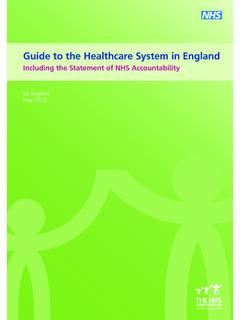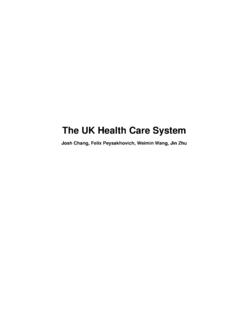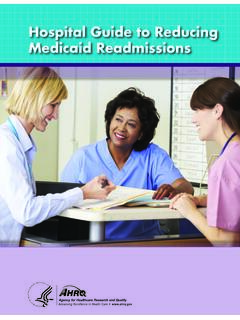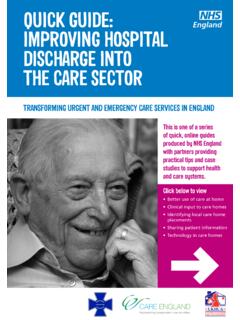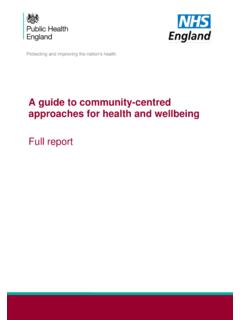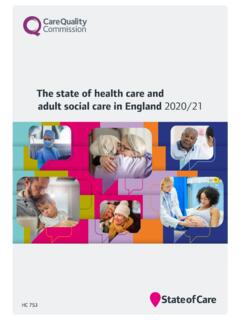Transcription of Shared Decision Making Summary guide - NHS England
1 Personalised Care Shared Decision Making Summary guide NHS England and NHS Improvement 2 SDM Mini guide v4 Contents Contents ..2 Introduction ..3 Who is this document for? ..5 What is Shared Decision Making ? ..6 What good Shared Decision Making looks like for people ..8 What good Shared Decision Making looks like for the system ..9 How Shared Decision Making fits with other personalised care components .. 11 What guidance and resources are available? .. 12 Introduction Shared Decision Making is part of the NHS Long Term Plan s commitment to make personalised care business as usual across the health and care system . Personalised care means people have choice and control over the way their care is planned and delivered, based on what matters to them and their individual strengths and needs.
2 This happens within a system that makes the most of the expertise, capacity and potential of people, families and communities in delivering better outcomes and experiences. Personalised care takes a whole- system approach, integrating services around the person. It is an all-age model, from maternity and childhood through to end of life, encompassing both mental and physical health support. This represents a new relationship between people, professionals and the health and care system . It provides a positive shift in power and Decision Making that enables people to feel informed, have a voice, to be heard and be connected to each other and their communities. Personalised care is implemented through the Comprehensive Model for Personalised Care (see Figure 1).
3 The model has been co-produced with a wide range of stakeholders and brings together six evidence-based and inter-linked components, each defined by a standard, replicable delivery model. These components are: 1. Shared Decision Making 2. Personalised care and support planning 3. Enabling choice, including legal rights to choice 4. Social prescribing and community-based support 5. Supported self-management 6. Personal health budgets and integrated personal budgets. The deployment of these six components will deliver: whole-population approaches, supporting people of all ages and their carers to manage their physical and mental health and wellbeing, build community resilience, and make informed decisions and choices when their health changes a proactive and universal offer of support to people with long term physical and mental health conditions to build knowledge, skills and confidence to live well with their health condition intensive and integrated approaches to empower people with more complex needs, including those living with multi-morbidity, to experience co-ordinated care and support that supports them to live well, helps reduce the risk of becoming frail, and minimises the burden of treatment.
4 4 SDM checklist Feb 2019 Figure 1: Comprehensive Model for Personalised Care
5
6 More information about the Comprehensive Model for Personalised Care, and supporting Summary guides for its successful implementation, are available on the personalised care pages of the NHS England 1 5 SDM checklist Feb 2019 Who is this document for? This Summary guide is aimed at people leading local implementation of Shared Decision Making (SDM). It enables: increased understanding of what good SDM looks like and how it ensures that we commission and provide systems and services that informed individuals want commissioning of local SDM initiatives and embedding them in care pathways providers to have better conversations with people using services, thereby supporting them to make more informed choices based on their personal values and preferences and what is known of the risks, benefits and consequences of the options available to them.
7 The implementation checklist attached to this guidance2 is a practical tool to help you start or continue conversations to understand where you are locally on SDM and to support local improvements. This guide provides best practice advice, not statutory guidance. 2 6 SDM checklist Feb 2019 What is Shared Decision Making ? People want to be more involved in decisions about their health and SDM ensures that people are supported to be as involved in the Decision Making process as they would wish. SDM means people are supported to: understand the care, treatment and support options available and the risks, benefits and consequences of those options make a Decision about a preferred course of action, based on evidence-based, good quality information and their personal preferences.
8 It is, therefore, a process in which clinicians and individuals work together to select tests, treatments, management or support packages, based on evidence and the individual s informed SDM is relevant in any non-life threatening situation when a health or care Decision needs to be made and a range of options (including doing nothing) is available. SDM ensures that individuals are supported to make decisions based on their personal preferences and are, therefore, more likely to adhere to evidence based treatment regimes, more likely to have improved outcomes and less likely to regret the decisions that are By paying attention to individuals informed preferences we can support people to achieve outcomes that matter to them.
9 Aggregating the decisions of informed individuals to a population level means we can commission and provide services that informed people want and therefore allocate resources more efficiently. A systematic review found that SDM interventions significantly improve outcomes for disadvantaged By addressing people s level of health literacy when sharing decisions we can also reduce health inequalities. Staff should use health- 3 Care Quality Commission (2017), Better care in my hands: a review of how people are involved in their care. Available online: (accessed 23 October 2018) 4 NICE / NHS England (2016), Shared Decision Making : a consensus statement. Available online: (accessed 23 October 2018) 5 Stacey, D.
10 Et al. (2014), Decision aids for people facing health treatment or screening decisions, Cochrane Database Syst. Review (1): CD001431 6 Durand, , Carpenter, L., Dolan, H., et al. (2014), Do interventions designed to support Shared Decision - Making reduce health inequalities? A systematic review and meta-analysis. PLoS One 9(4):e94670 7 SDM checklist Feb 2019 literate Decision support materials (when such materials are available) and tailor their conversations to take account of low health literacy by using specific techniques, building on the health literacy SDM is driven by the duties for NHS England set out in the NHS Act 2006 as amended by the Health and Social Care Act 2012 to: promote individual participation in decisions about care, treatment, tests, and prevention of illness; promote patient choice; and exercise its functions with a view to securing continuous improvement in the quality of services.










